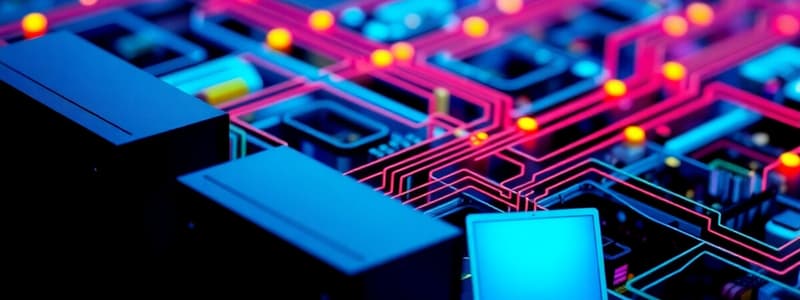Podcast
Questions and Answers
What is the primary function of a computer network?
What is the primary function of a computer network?
To enable computers to communicate and share resources, data, and applications.
Name three examples of physical resources that can be shared in a computer network.
Name three examples of physical resources that can be shared in a computer network.
Printers, tape backup systems, and storage devices are a few examples.
Briefly describe the client-server model and its significance in network usage.
Briefly describe the client-server model and its significance in network usage.
The client-server model involves clients requesting services from servers. It is a fundamental architecture for many network applications.
What is VoIP, and how does it relate to computer networks?
What is VoIP, and how does it relate to computer networks?
Explain how 'desktop sharing' enhances remote work capabilities within a network.
Explain how 'desktop sharing' enhances remote work capabilities within a network.
What is e-commerce, and how has its growth impacted business applications of computer networks?
What is e-commerce, and how has its growth impacted business applications of computer networks?
Describe the difference between a LAN, MAN, and WAN.
Describe the difference between a LAN, MAN, and WAN.
Give an example of how computer networks facilitate resource sharing within a company.
Give an example of how computer networks facilitate resource sharing within a company.
Explain how resource sharing in a computer network can lead to cost savings for an organization?
Explain how resource sharing in a computer network can lead to cost savings for an organization?
Describe a scenario where the high reliability of a computer network proves beneficial.?
Describe a scenario where the high reliability of a computer network proves beneficial.?
How does the client-server model contribute to cost savings in a networked environment?
How does the client-server model contribute to cost savings in a networked environment?
Explain how scalability in computer networks can accommodate growing workloads without significant infrastructure overhauls.
Explain how scalability in computer networks can accommodate growing workloads without significant infrastructure overhauls.
Provide two examples, other than printing, of resource sharing in a computer network and the benefits they offer.
Provide two examples, other than printing, of resource sharing in a computer network and the benefits they offer.
Explain how mobile technologies like GPS and NFC are utilized in m-commerce.
Explain how mobile technologies like GPS and NFC are utilized in m-commerce.
How does peer-to-peer communication differ from person-to-person communication in home applications, and give an example of each?
How does peer-to-peer communication differ from person-to-person communication in home applications, and give an example of each?
Discuss one potential social issue that has emerged due to increased network usage and connectivity.
Discuss one potential social issue that has emerged due to increased network usage and connectivity.
Explain how DNS simplifies network communication for users.
Explain how DNS simplifies network communication for users.
Differentiate between TCP and UDP in terms of reliability and use cases.
Differentiate between TCP and UDP in terms of reliability and use cases.
What are the key advantages of the TCP/IP model that have contributed to its widespread adoption?
What are the key advantages of the TCP/IP model that have contributed to its widespread adoption?
Describe a scenario where using UDP would be more appropriate than using TCP. Explain why.
Describe a scenario where using UDP would be more appropriate than using TCP. Explain why.
Explain the primary function of the File Transfer Protocol (FTP).
Explain the primary function of the File Transfer Protocol (FTP).
What is the role of SMTP and in what context is it used?
What is the role of SMTP and in what context is it used?
Despite its merits, what are some of the noted shortcomings of the TCP/IP model?
Despite its merits, what are some of the noted shortcomings of the TCP/IP model?
Why was ARPANET originally created and what problem was it designed to solve?
Why was ARPANET originally created and what problem was it designed to solve?
In a bus topology, what happens if one workstation fails, and why?
In a bus topology, what happens if one workstation fails, and why?
Why is fault identification difficult in a bus topology?
Why is fault identification difficult in a bus topology?
What is a primary disadvantage of increasing the number of computers on a bus topology?
What is a primary disadvantage of increasing the number of computers on a bus topology?
How does a star topology centralize network control, and what is a potential drawback of this?
How does a star topology centralize network control, and what is a potential drawback of this?
What is the role of the central hub in a star topology?
What is the role of the central hub in a star topology?
Compare the cabling requirements of bus and star topologies. Which one requires more cabling, and why?
Compare the cabling requirements of bus and star topologies. Which one requires more cabling, and why?
In a star topology, how do nodes communicate with each other, and what is the implication of this communication method?
In a star topology, how do nodes communicate with each other, and what is the implication of this communication method?
What is the common implementation of bus topology?
What is the common implementation of bus topology?
What critical agreement between different networks led to the official 'birth' of the Internet, and what problem did this agreement solve?
What critical agreement between different networks led to the official 'birth' of the Internet, and what problem did this agreement solve?
Describe the roles of the Internet Society (ISOC) and the Internet Architecture Board (IAB) in the ongoing development and maintenance of the Internet.
Describe the roles of the Internet Society (ISOC) and the Internet Architecture Board (IAB) in the ongoing development and maintenance of the Internet.
Explain how the interconnection of ARPANET and NSFNET influenced the growth of the Internet.
Explain how the interconnection of ARPANET and NSFNET influenced the growth of the Internet.
What were the primary reasons behind the decision to dissolve ARPANET, and what happened to many of the sites that were connected to it?
What were the primary reasons behind the decision to dissolve ARPANET, and what happened to many of the sites that were connected to it?
Identify and briefly describe two factors that contributed to the rapid growth of the Internet.
Identify and briefly describe two factors that contributed to the rapid growth of the Internet.
In what year was ARPANET split, and into which two distinct networks was it divided? State the purpose of each of these new networks.
In what year was ARPANET split, and into which two distinct networks was it divided? State the purpose of each of these new networks.
What event is considered to be the 'official' birth of the Internet and why is it considered so?
What event is considered to be the 'official' birth of the Internet and why is it considered so?
Since 1986, several organizations contributed to the coordinated development of the internet, name two and specify their distinct purpose.
Since 1986, several organizations contributed to the coordinated development of the internet, name two and specify their distinct purpose.
Flashcards
Computer Network
Computer Network
A group of computers linked to communicate and share resources.
Node
Node
Any device in a network that can send/receive data.
OSI Model
OSI Model
A conceptual framework used to understand network communication layers.
TCP/IP
TCP/IP
Signup and view all the flashcards
WAN
WAN
Signup and view all the flashcards
LAN
LAN
Signup and view all the flashcards
Network Topology
Network Topology
Signup and view all the flashcards
VoIP
VoIP
Signup and view all the flashcards
OSI Model Layers
OSI Model Layers
Signup and view all the flashcards
Application Layer
Application Layer
Signup and view all the flashcards
File Transfer Protocol (FTP)
File Transfer Protocol (FTP)
Signup and view all the flashcards
HTTP/HTTPS
HTTP/HTTPS
Signup and view all the flashcards
Peer-to-peer communication
Peer-to-peer communication
Signup and view all the flashcards
Simple Mail Transfer Protocol (SMTP)
Simple Mail Transfer Protocol (SMTP)
Signup and view all the flashcards
Resource Sharing
Resource Sharing
Signup and view all the flashcards
TELNET
TELNET
Signup and view all the flashcards
Transport Layer
Transport Layer
Signup and view all the flashcards
High Reliability
High Reliability
Signup and view all the flashcards
Data Link Layer
Data Link Layer
Signup and view all the flashcards
Saving Money
Saving Money
Signup and view all the flashcards
Scalability
Scalability
Signup and view all the flashcards
M-commerce
M-commerce
Signup and view all the flashcards
NFC (Near Field Communication)
NFC (Near Field Communication)
Signup and view all the flashcards
Social Issues of Technology
Social Issues of Technology
Signup and view all the flashcards
FTP
FTP
Signup and view all the flashcards
SMTP
SMTP
Signup and view all the flashcards
DNS
DNS
Signup and view all the flashcards
TCP
TCP
Signup and view all the flashcards
UDP
UDP
Signup and view all the flashcards
Merits of TCP/IP
Merits of TCP/IP
Signup and view all the flashcards
Demerits of TCP/IP
Demerits of TCP/IP
Signup and view all the flashcards
ARPANET
ARPANET
Signup and view all the flashcards
NSFNET
NSFNET
Signup and view all the flashcards
1990 ARPANET dissolution
1990 ARPANET dissolution
Signup and view all the flashcards
TCP/IP Protocol
TCP/IP Protocol
Signup and view all the flashcards
Internet Society (ISOC)
Internet Society (ISOC)
Signup and view all the flashcards
Factors for Internet Growth
Factors for Internet Growth
Signup and view all the flashcards
Bus Topology
Bus Topology
Signup and view all the flashcards
Advantages of Bus Topology
Advantages of Bus Topology
Signup and view all the flashcards
Disadvantages of Bus Topology
Disadvantages of Bus Topology
Signup and view all the flashcards
Star Topology
Star Topology
Signup and view all the flashcards
Central Hub
Central Hub
Signup and view all the flashcards
Cable Usage in Star Topology
Cable Usage in Star Topology
Signup and view all the flashcards
Ease of Installation
Ease of Installation
Signup and view all the flashcards
Fault Identification
Fault Identification
Signup and view all the flashcards
Study Notes
Computer Networks
- Computer networks link computers to share resources, data, and applications.
- Nodes (computers, printers) are connected by communication links.
- Networks use various technologies (copper wire, fiber optics, etc.) for connections.
Uses of Computer Networks
- Business: Distribute information, share resources (printers, backups), enable client-server model, facilitate employee communication (email, VoIP). Electronic commerce (e-commerce) is a rapidly growing form of business.
- Home: Peer-to-peer communication, e-commerce, entertainment (games), and more.
- Mobile Users: Text messaging, smartphones, GPS, m-commerce, Near Field Communication (NFC).
- Social Issues: New freedoms and social, political, and ethical issues related to their use.
Advantages of Networks
- Resource Sharing: Accessing software, hardware, and data regardless of physical location.
- High Reliability: Multiple backups for files and data can help avoid total network failure if one component fails.
- Cost Savings: Personal computers are often more cost-effective than large mainframe systems.
Networking Models
- Networks are often organized as stacked layers to simplify design and workload distribution.
- Layers divide the network's functions, allowing easier maintenance and scalability.
OSI Reference Model
- The OSI model is a conceptual model that describes how data transfers through a network.
- It has seven layers, each with specific functions: Application, Presentation, Session, Transport, Network, Data Link, and Physical.
- The model describes data transfer without regard for physical implementation.
TCP/IP Model
- The TCP/IP model is a simpler, 4-layer model of network communication.
- It encompasses many protocols.
Network Topologies:
- Bus: All devices connected to a central cable (backbone).
- Star: Devices connect to a central hub or switch.
- Ring: Devices connected in a closed loop, data passes in one direction.
- Tree: A combination of bus and star topologies, hierarchically structured.
- Mesh: Nodes interconnected, provides redundancy and fault tolerance.
- Cellular: Nodes communicate wirelessly through cells, uses a central hub for routing data.
Types of Computer Networks:
-
LAN (Local Area Network): Connects devices within a limited area (e.g., building, office). -Wired and wireless setups.
-
MAN (Metropolitan Area Network): A larger network covering a city or metropolitan area.
-
WAN (Wide Area Network): Covers a large geographic area (e.g., country, world). Consists of multiple LANs connected across a larger geographical area.
Studying That Suits You
Use AI to generate personalized quizzes and flashcards to suit your learning preferences.




